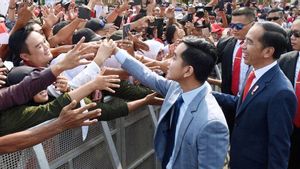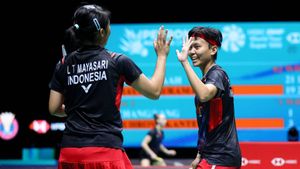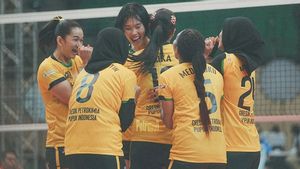JAKARTA - Edy Kaha (38), until now, is still harboring trauma over what happened to him in May 1998. The shopping center in Glodok, Jakarta, which is located not far from his house, caught fire. A number of people continue to sweep, looking for shops that can be looted. The May 1998 riots were an event that the Indonesian government acknowledged as a gross human rights violation.
I saw people looting televisions, washing machines, clothes, and carrying trolleys for basic food workers. Without fear of being arrested or shouted at by thieves, "said this resident of Kemayoran, Central Jakarta to VOI, Tuesday (17/1).
At that time, Edy was 15 years old. He still clearly remembered the teachers suddenly ordered all students to return home.
"I had time to ask, why is that? Come home quickly, you will be targeted later," Edy said.
For several days, he and his parents and two siblings never left the house. All relatives asked each other how they only used the house phone.
Some relatives are already abroad looking for safety. When I saw the news on TV, I was also shocked because it happened simultaneously everywhere. I thought it was only in Jakarta. In fact, the conditions were really chaotic," he said.
Until now, he did not understand why the Chinese were targeted.
"We look different, called China, and others. In fact, we are purely Indonesian, born in Indonesia, just like other ethnicities. We cannot choose which ethnicity," said Edy.
Based on data from the Joint Fact Finding Team (TGPF), more than 1,000 people were victims in the May 1998 incident in Jakarta.
Human Rights (HAM) activist Ester Indahyani Jusuf assessed that the May 1998 incident and a number of gross human rights violations in the past were still black records of the nation's history which were never resolved legally, both nationally and internationally. Because, always clashing with the political process.
In accordance with the Human Rights Court Law, the judicial process must go through the Adhoc Human Rights Court which was formed based on the proposals of the DPR RI and the Presidential Decree. This political process is the bastion for inhibiting the juridical process to investigate, investigate, prosecute, and try," said Ester to VOI, Tuesday (17/1).
The proof is also difficult. Past gross human rights violations always refer to the line of command. Performed by groups with very strong power and capital. According to Ester, the perpetrators or operators in the field, witnesses and victims may choose to keep their mouths shut, they understand the risks. There is no guarantee of security for them personally or for their families.
However, the Presidential Decree No. 17 of 2022 concerning the formation of a Non-Judicial Settlement Team for Violation of Human Rights that is Heavy in the Past or called the PPHAM Team can be interpreted as progress and creative effort in terms of handling victims.
"Of course it's very good, the state has acknowledged and is willing to take responsibility," said Ester.
As stated by President Joko Widodo (Jokowi) on January 11,: "With a clear mind and a sincere heart, I as the Head of State admit that gross human rights violations have indeed occurred in various events in the country."
"The government and I are trying to restore the rights of the victims fairly and wisely, without negating a judicial settlement. The government will seriously try to prevent gross human rights violations in the future," added Jokowi.
Even so, Ester suggested that the mechanism for restoring victims' rights was clearly designed so that later there would be no conflict.
There must be parameters first so that there are no mistakes. Who are the victims and who are the heirs. Don't let anyone claim to be victims. Then, determine compensation. Is it equalized to insurance standards or what, and so on," said Ester.
Furthermore, it is related to prevention. Every type of gross human rights violation has a source of causes, symptoms, characteristics, and different variables. Examples of genocide or all actions aimed at destroying groups, nations, ethnicities, races, or religions.
The pattern commonly used, according to Ester, is the party who wants genocide to first design the source of the cause. It can be through instilling social diseases such as feudalism, racism, blind fanaticism, or planting all values that have an impact on dehumanization.
The disease is then produced to grow and be structured, so that it has damaged power. Production is carried out in various ways. Such as through the literature, the teachings of educators, parents, leader of the ummah, or traditional head.
Era saat ini, produksi nilai dapat sangat masif lewat perkembangan teknologi. Kita bisa lihat gejalanya munculnya kebencian pada kelompok sasaran. Klompok ini distigma sebagai kelompok jahat, dibatasi ruang gerak, mencari atau diciptakan kesalahan, dan dijadikan tembahatan bersama. Posisi ini membuat pemusnahan manusia pada kelompok sasaran mendapat dukungan. Min minimum tidak mendapat perlawan yang berarti, kata Ester menerangkan.
In simple terms, the scheme is variables in the form of values, doctrines, ideologies, and reasons for genocide. Also, there are variables that spread and maintain it.
After the loading period is sufficient, the situation matures, so there is only a small trigger for genocide to occur, "Ester continued.
Thus, preventive action is needed. According to Ester, the basic thing is resistance to all evil values or doctrines. However, it is rather difficult if the agents who spread social diseases are traditional or religious leaders, are chaired or highly respected, especially if they have power and have many acts of generosity in society.
"It's all well-designed and correct if you really want to achieve justice. It's not easy, but at least there are preventive steps that must be taken when symptoms appear," said Ester.
The Intermediate Expert of the Presidential Staff Office (KSP), Mugiyono, said the President would soon issue an Inpres on the settlement of non-judicial gross human rights violations in the past (PPHAM). Distributing tasks to 17 ministries/non-ministerial agencies.
Also, form a special team that will evaluate and control the implementation of each of these recommendations.
"Whether it's called a task force or whatever later. In essence, the government is serious about solving past human rights issues," said Mugiyono to VOI, Tuesday (17/1).
What is needed by victims, what impacts are experienced as victims of gross human rights violations. This will then be met by the state as a form of recovery.
"The form is that there are materials and non-materials, some are collective individuals. Later the new team formed will detail it again," he said.
However, said Mugiyono, only victims of 12 cases of human rights violations were recommended by the PPHAM team, namely:
"So, if there are questions as to why other cases such as Munir cases, KM 50 cases, Kanjuruhan, and July 27 do not come in, because these cases have never been investigated and concluded by Komnas HAM as gross human rights violations," he said.
Ester invites all parties to respect each other, maintain the integrity of the Republic of Indonesia.
We must be introspective so that we do not become spreaders of doctrine or evil values. I call on you, leaders, educators, or if you are a respected figure. Try to be critical of any idea or thought," said Ester.
"If your leader is not a figure who wants to fight for noble human values, this is the time for you to rise and become a leader, a human defender, a system that protects individuals and society," added Ester again.
The English, Chinese, Japanese, Arabic, and French versions are automatically generated by the AI. So there may still be inaccuracies in translating, please always see Indonesian as our main language. (system supported by DigitalSiber.id)










